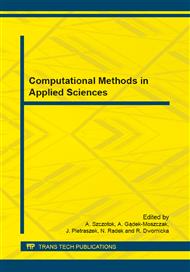p.37
p.43
p.49
p.55
p.63
p.69
p.75
p.81
p.87
Analysis of Thick-Walled Pipeline Elements Operating in Creep Conditions
Abstract:
In some coal-fired power plants, pipeline elements have worked for over 200 000 hours and increased number of failures is observed. The paper discuses thermal wear processes that take place in those elements and lead to rupture. Mathematical model based on creep test data, and describing creep processes for analyzed material, has been developed. Model has been verified for pipeline operating temperature, lower than tests temperature, basing on Larson-Miller relation. Prepared model has been used for thermal-strength calculations based on a finite element method. Processes taking place inside of element and leading to its failure has been described. Than, basing on prepared mathematical creep model and FE model introduced to Ansys program further researches are made. Analysis of dimensions and shape of pipe junction and its influence on operational element lifetime is presented. In the end multi variable dependence of temperature, steam pressure and element geometry is shown, allowing optimization of process parameters in function of required operational time or maximization of steam parameters. The article presents wide range of methods. The creep test data were recalculated for operational temperature using Larson-Miller parameter. The creep strain were modelled, used equations and their parameters are presented. Analysis of errors were conducted. Geometry of failing pipe junction was introduced to the Ansys program and the finite element analysis of creep process were conducted.
Info:
Periodical:
Pages:
63-68
Citation:
Online since:
January 2015
Authors:
Keywords:
Price:
Сopyright:
© 2015 Trans Tech Publications Ltd. All Rights Reserved
Share:
Citation:


